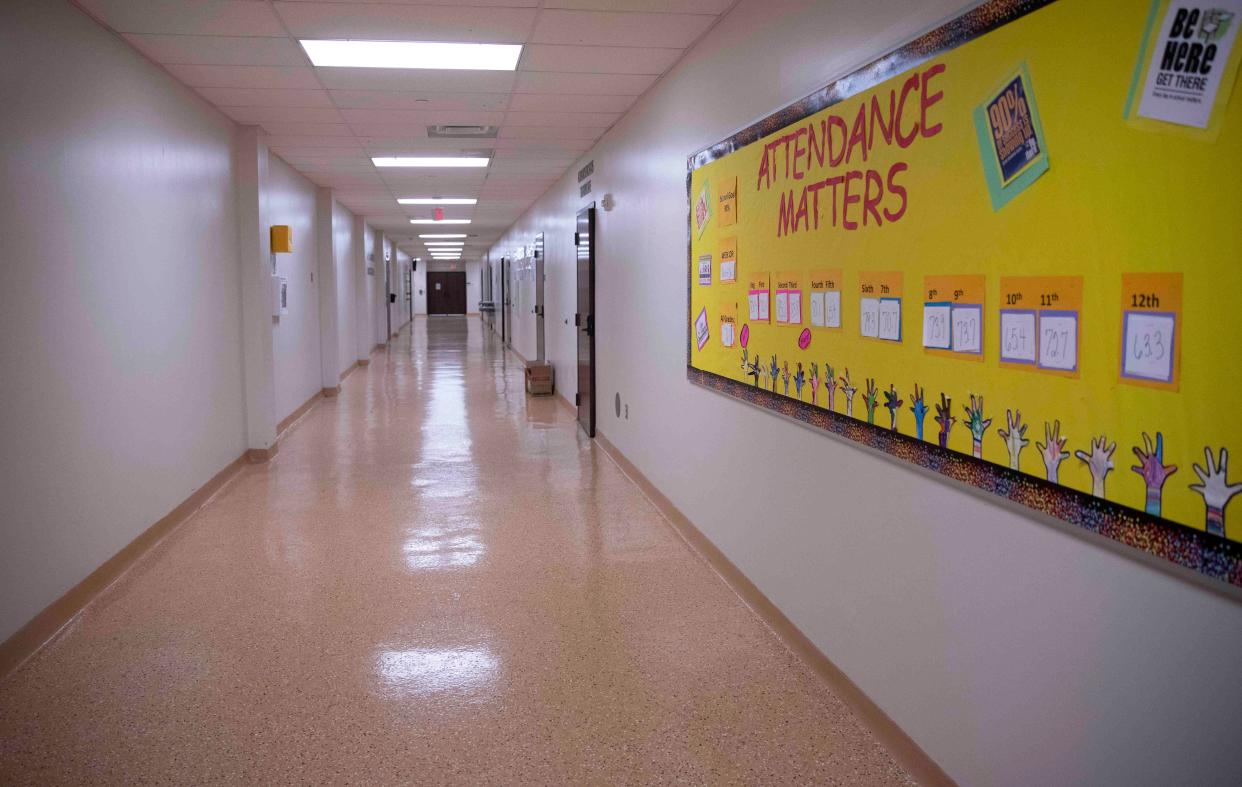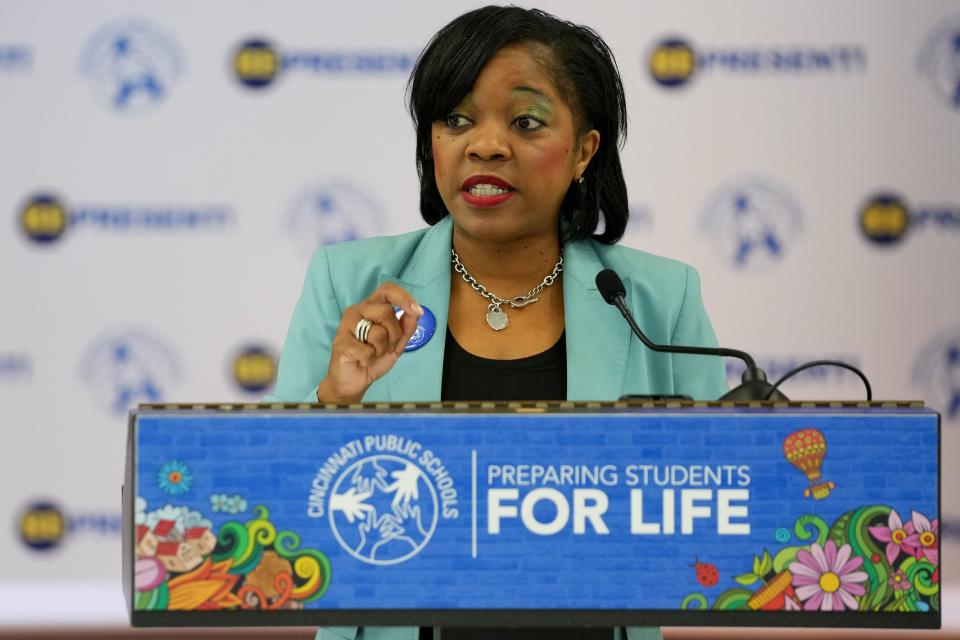Why a CPS plan to add middle schools could both save and complicate the budget process

Cincinnati Public Schools is pushing ahead with a plan to switch grades 6-8 to middle schools as early as next school year amid budget cuts that will impact transportation and extracurricular options for some students.
The board has chipped away at a multimillion-dollar budget gap since January, and the books need to be balanced by June. After a lengthy budget discussion during Monday's school board meeting − at which the board voted to consolidate yellow bus routes and reduce stipends for athletics, among other cuts − the board passed a resolution directing Superintendent Iranetta Wright's team to begin planning next steps for middle schools.
Now, most of the district's schools house kids in K-12, in K-6 and in 7-12. There are no middle schools in the district. The work will include redrawing enrollment maps so the district has neighborhood schools in the city's west, central and east areas.
Are yellow buses next? Cincinnati school board needs to cut $20 million more
At least one board member questioned the wisdom of dealing with both projects at one time.
"I don't think this is the priority right now when we still have $16 million to close in our budget," board member Ben Lindy said during Monday's meeting. He and Kendra Mapp voted against the resolution. "We're asking the administration to climb Mount Everest and then we're telling them to juggle at the same time."
But Board President Eve Bolton doesn't see it that way. She told The Enquirer that there's been a focus on "closing the budget gap" instead of looking at district finances holistically and planning for the district's future. That future includes a vision to reorganize school systems − creating more options for families − and incorporate middle schools that will serve a traditionally difficult age group: grades 6-8.
It's also likely that the switch to neighborhood schools with middle schools will save the district "a great deal of money" in the long run, Bolton said. Which is why, in a perfect world, those details would have come out long before budget discussions.
Instead, she said, the district continues to consider cuts that don't align with the board's long-term goals.
CPS up to $65 million in budget cuts, still millions to go
For example, options to expand the walking radius for yellow buses and to place students in grades seven and eight on Metro were both shot down by the school board.
Superintendent Wright presented these options to the board several times but backed down on the Metro suggestion earlier this month. That potential change, which would save the district $5.5 million, does not gel with the board's plan for middle schools, she said.
"Then we would move seventh and eighth grade students from yellow buses this year to put on Metro next year with the possibility of putting them back on yellow buses the following year," Wright said during a March school board meeting. "Trying to think it out for a longer period of time ... it just didn't seem prudent."
The school board also shot down Wright's proposal to cut resource coordinator positions in half. These coordinators are the bridge between schools, students and communities and promote partnerships with local organizations to best serve kids.

The superintendent and board have agreed on $65 million worth of cuts so far. Decisions include reducing central office staff, eliminating the Summer Scholars program, cutting full-time substitute teachers in lieu of daily subs and doing away with assigned take-home devices for students in preschool through grade 6. Kids in those grades will still be able to check out tablets or laptops to take home if needed, the superintendent clarified on Monday.
The board also approved a reduction in extracurricular funding. The district said those funds were increased for the 2023-24 school year with COVID-19 relief dollars. But next school year, stipends for coaches and club sponsors will return to what they were pre-pandemic.
There is still at least $15 million left to cut in order to balance the budget, Wright said. Bolton thinks it's much more than that, once the district accounts for other upcoming costs.
In the face of these cuts, Brad Smith, a teacher in the district, spoke at Monday's board meeting about the extra administrative positions Wright created at the start of her tenure. The longer the chain of command to the top, he said, the longer it takes to make key decisions about how to support kids.
"All of this administrative bloat, I would say that this is far from extraordinary district leadership," Smith said. "Instead, what I see is just disruption, delaying and deflecting."
First middle school possible this fall
So, what is the board's vision for middle schools?
An ad hoc committee dedicated to reviewing the district's school boundary lines spent the last 18 months speaking with community members and developing a strategy to best meet the needs of students and families in Cincinnati. The result, board member Kareem Moffett said, is a plan to zero in on neighborhood school systems that include at least four middle schools and upgrade to a more efficient transportation system.
The district spends more than $38 million on transportation each year. A recent breakdown of per school transportation costs show that some schools bus fewer than a dozen kids and still spend an extravagant amount of money on transportation.
Winton Hills Academy, for example, has four students who use yellow bus transportation. The yearly cost for those kids to get to school is $50,000.
"There are schools we cannot afford," Bolton said Monday.

Redrawing school enrollment lines to reflect city-recognized neighborhoods should significantly reduce those costs, Bolton said. And "if the stars align," Moffett said, that process will begin in the fall − including, hopefully, the first year of a CPS middle school.
The goal is to slowly build out middle schools in repurposed buildings by grade bands over three years. The district will decide which buildings to change based on utilization data and student demographics, Moffett said. Communities will continue to have a voice in the process, too, because "those communities know what they need."
Not everyone is for the idea. Educators at district schools with low enrollments, in danger of being repurposed for the middle school project, came to recent school board meetings in tears.
"Understand just what it is that you are dismantling," said Megan Albright, a teacher at Woodford Academy.
Her colleague, Melinda Wallace, teaches music at the school. Making Woodford a middle school wouldn't make sense, physically, she said. The toilets, chairs and other facilities are "built for little humans."
Schools with specialized programs like the School for the Creative and Performing Arts, Walnut Hills High School and Spencer Center for Gifted and Exceptional Students will not be impacted, Moffett said.
It's unclear yet if middle schools will be costly for the district. Bolton doesn't think so, but those details haven't been provided yet.
Moffett thinks the vision is a good one, regardless of potential costs, because it was dreamt up by the community itself.
"We may have to invest to prioritize that plan," Moffett said. "But I don't think it should be thought of as a deficit."
This article originally appeared on Cincinnati Enquirer: Cincinnati Public Schools to add middle schools in the next 2-3 years

